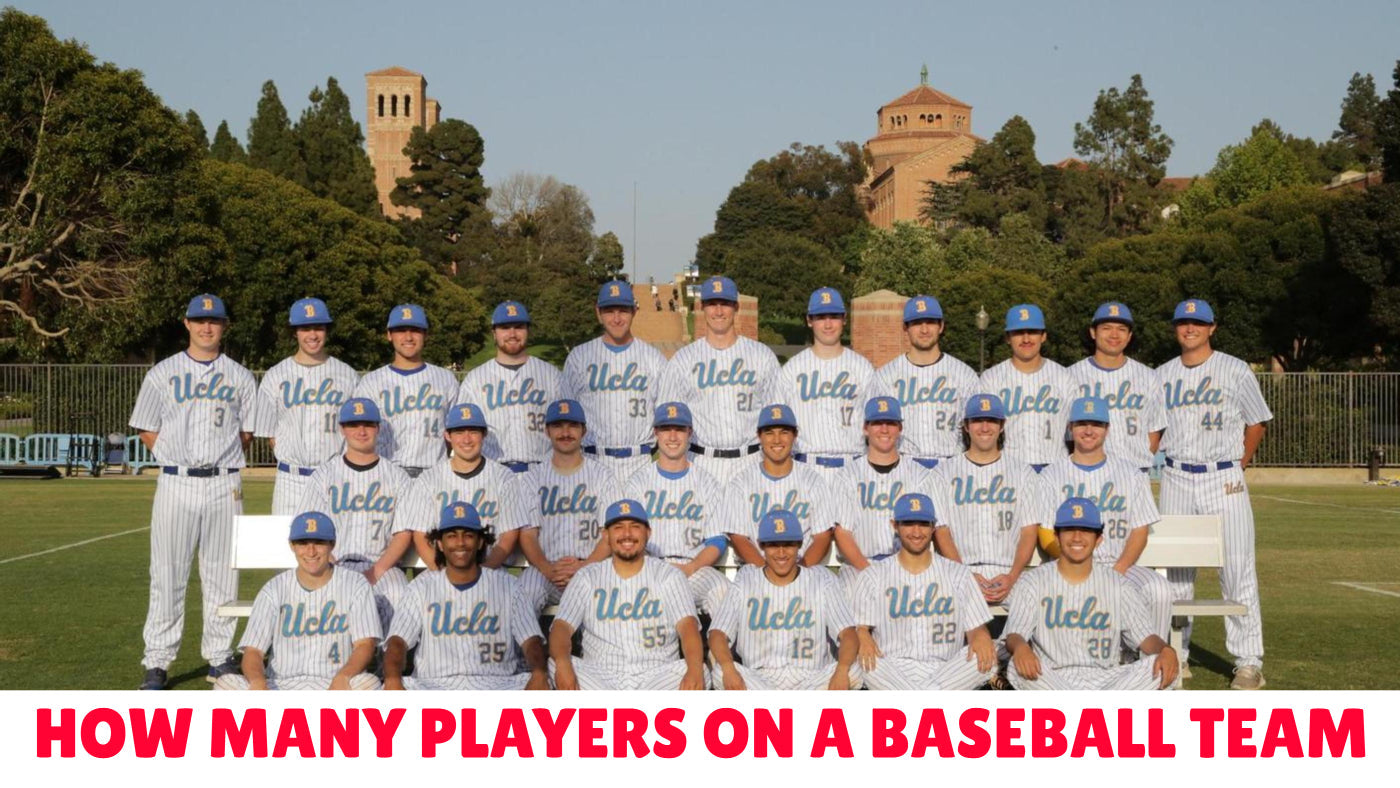Your Cart is Empty
- Mother's Day 🌷
- Gift for Family 🏠❤️
-
Pet
-
Memorial
-
Products
-
Home & Garden
-
Accessories
- Happy Customers ❤️
How Many Players Are On A Baseball Team? Baseball Team Rosters
July 30, 2023 6 min read

Baseball, often called America's favorite pastime, has captured the hearts of sports enthusiasts around the world. As the sport evolved, so did the composition of baseball teams and their rosters. Understanding the number of players on a baseball team is crucial to comprehend the game's intricacies and strategies. In this comprehensive guide, we'll explore the standard roster size, the rules governing Major League Baseball (MLB) rosters, the significance of minor league teams, and how roster decisions impact the game.
Contents
1. The Standard Baseball Team Roster 2. Major League Baseball (MLB) Roster Rules 3. Understanding Minor League Baseball Rosters 4. Historical Evolution of Baseball Team Rosters 5. The Importance of Bench Players and Utility Players in Baseball Team 6. Baseball Team Management and Roster Decisions 7. Roster Changes and Trades in Baseball 8. Roster Size and Competitive Balance in Baseball 9. Conclusion
1. The Standard Baseball Team Roster

In baseball, a team's roster is vital for its success. The active roster refers to the number of players eligible to participate in games. Traditionally, a baseball team's active roster during the regular season consists of 25 players. This number ensures teams have enough players to fill key positions, such as pitchers, catchers, infielders, and outfielders.
However, please note that specific league rules or team preferences might result in slight variations in roster sizes or player positions. Below is a breakdown of the standard positions and player types you would typically find on a baseball team:
- Starting Pitchers (SP): Usually, a team will have five starting pitchers who are responsible for beginning the games. They pitch the majority of innings and are expected to provide quality starts for their team.
- Relief Pitchers (RP): The bullpen consists of relief pitchers who come into the game after the starting pitcher. Their role is to provide shorter stints of effective pitching to bridge the gap between the starting pitcher and the closer.
- Closer (CL): The closer is a specialized relief pitcher whose primary role is to pitch the final inning or innings of a close game. They are typically brought in to protect a narrow lead and secure the victory for the team.
- Catcher (C): The catcher is a defensive player who wears protective gear and is positioned behind home plate. Their primary responsibility is to catch the pitches thrown by the pitchers and work closely with them to call pitches and manage the game.
- First Baseman (1B): Positioned near first base, this player is responsible for fielding grounders, receiving throws, and making plays to record outs at first base. Additionally, they are typically power hitters in the lineup.
- Second Baseman (2B): Positioned near second base, this player is involved in turning double plays, fielding ground balls, and covering the base during defensive plays.
- Shortstop (SS): Positioned between second and third base, the shortstop is an important infielder responsible for fielding ground balls, covering second base, and making plays to record outs.
- Third Baseman (3B): Positioned near third base, this player has a similar defensive role to the first and second basemen, but they also need strong throwing accuracy to make plays from deep in the infield.
- Outfielders (LF, CF, RF): The outfield consists of three players: left fielder (LF), center fielder (CF), and right fielder (RF). Their primary responsibility is to catch fly balls and line drives hit into the outfield and to prevent extra-base hits.
- Designated Hitter (DH): In leagues that use the designated hitter rule (like the American League in MLB), a designated hitter is used to bat in place of the pitcher. This player's sole role is to hit and not play a defensive position.
2. Major League Baseball (MLB) Roster Rules
MLB, the premier professional baseball league, governs its roster size based on collective bargaining agreements between the league and the MLB Players Association. Over the years, the MLB roster size has undergone changes, but it has generally remained at 25 players for the regular season. However, exceptions arise when players are placed on the Injured List (IL). In such cases, teams may call up players from their minor league affiliates or select players from their 40-man roster to fill the void temporarily.
The Postseason also sees roster changes as teams expand their rosters to accommodate additional players. This expansion aims to provide more depth and flexibility during the playoffs and World Series.
"Grandma's cheering section”
3. Understanding Minor League Baseball Rosters
Minor league baseball plays a significant role in player development and acts as a stepping stone for aspiring players to reach the MLB. Minor league rosters, unlike their MLB counterparts, vary in size and composition. Minor league teams are categorized into different levels, such as Triple-A, Double-A, Class-A, and Rookie ball, each with its roster rules.
These leagues typically have larger rosters to accommodate prospects at various stages of development. Roster size can range from 25 to 35 players, giving teams the flexibility to rotate players and develop their skills effectively.
4. Historical Evolution of Baseball Team Rosters
The early days of baseball featured smaller teams with fewer players compared to modern times. As the sport gained popularity, the roster size gradually increased to meet the demands of a more complex game. During the early 20th century, teams had around 10 players, but this number steadily grew to the 25-player standard seen today.
Advancements in player training, talent scouting, and changes in the game's strategies contributed to the evolution of baseball team rosters. The expansion era of the 1960s saw an increase in MLB teams, leading to a higher demand for players and larger rosters.
5. The Importance of Bench Players and Utility Players in Baseball Team
A well-constructed roster requires a mix of star players and versatile role players. Bench players and utility players are integral to a team's success, providing essential backup and depth. Bench players are non-starters who can be called upon to substitute injured or struggling players, ensuring a seamless flow of gameplay.
Utility players, on the other hand, possess the ability to play multiple positions, making them invaluable assets to teams. Their adaptability allows managers to make strategic changes during games, enhancing the team's chances of victory.
Iconic utility players like Tony Phillips and Ben Zobrist have demonstrated the significance of such players in championship-winning teams.
6. Baseball Team Management and Roster Decisions
Team managers and general managers play crucial roles in roster construction. Building a successful roster involves striking a balance between pitching staff and position players. Managers need to consider player strengths, weaknesses, and game situations when making roster decisions.
Pitching rotations are carefully crafted to ensure that starting pitchers and relievers are available when needed. Position players are selected based on their offensive and defensive capabilities, with consideration given to matchups against opposing pitchers.
7. Roster Changes and Trades in Baseball

"Curse of the Bambino"
Throughout the season, teams may make roster changes and engage in player trades. Player trades involve swapping players between teams to address specific needs or enhance team performance. A well-executed trade can bring valuable players to a team and impact its roster composition significantly.
Notable trades in baseball history, like the "Curse of the Bambino" trade between the Red Sox and Yankees, exemplify how roster changes can shape the course of a team's success or failure.
8. Roster Size and Competitive Balance in Baseball
The roster size in baseball can influence the competitive balance in the league. A larger roster allows teams to have more depth and options to adapt during the long and demanding season. However, it also impacts player salaries and team budgets, as more players mean higher expenses.
The debate surrounding roster size centers on whether a larger roster promotes better competition or if a smaller roster encourages teams to focus on developing star players for a more intense and competitive game.
9. Conclusion
Understanding the dynamics of baseball team rosters is crucial for appreciating the intricacies of the game. The standard 25-player roster in MLB, along with the flexibility in roster size during the postseason, ensures teams have the necessary resources to succeed. Minor league baseball also plays an essential role in developing talent and preparing players for the highest level of the sport.
The significance of bench players and utility players cannot be overstated, as they add depth and versatility to the team. Team management's strategic roster decisions, including player trades, shape the destiny of baseball franchises.
As baseball continues to evolve, the balance between roster size and competitive balance will remain a topic of discussion. Nevertheless, the game's essence lies in the synergy of players coming together as a team, making baseball one of the most beloved sports globally, and its roster composition a crucial aspect of the sport's legacy.
Related products for Baseball Lovers:

Hazel Edison
Hazel Edison's mission as a content marketer and social media manager is to help businesses connect with their target audience through engaging and informative content. With a deep understanding of the power of digital media, Hazel is committed to helping the brand build its online presence and drive results.
Related articles in Baseball

What Is a Quality Start in Baseball? Understanding the Pitching Metric
August 27, 2023 7 min read
Read More


